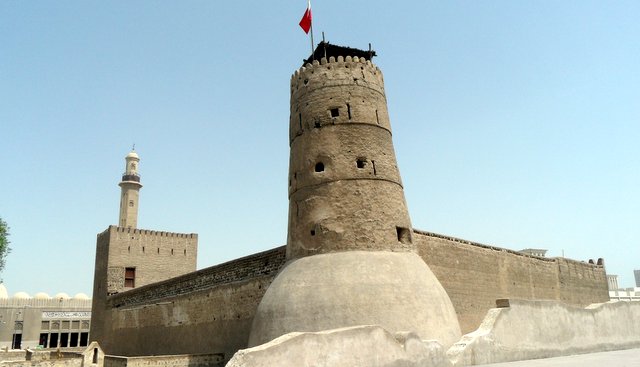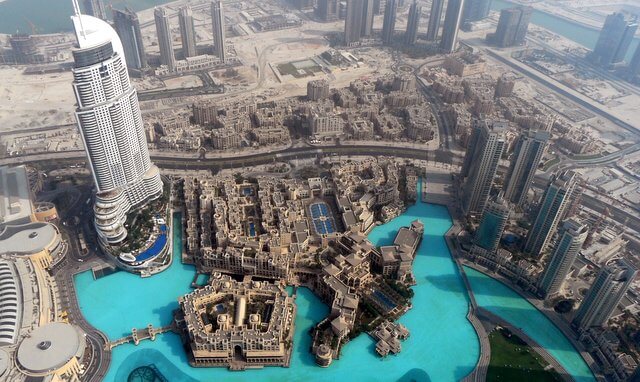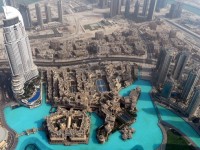
The UAE is a federation of seven emirates on the eastern side of the Arabian Peninsula. Whilst Abu Dhabi is the capital, most visitors come to Dubai which is the transport and commerce centre for the UAE.
Following the discovery of oil, Dubai was built out of nothing around a small creek in the desert. In just 20 years it’s become a modern city with every amenity possible. This has led to problems: the whole city is still a construction site – very few places look finished. Also the lack of fresh water means that all water has to come from the sea and 12 desalination plants create all the water required not just for drinking, but enough to create garden and grass verges throughout the city. The oil used to run a desalination plant for one hour would run a Toyota Land Cruiser 24h day for 17 years.
The city is too spread out to walk around and the metro cheap but inconvenient for anywhere off the seafront, so the most realistic way around is taxis or to hire a driver for the day. Fortunately this is very cheap due to cheap petrol and the influx of low cost foreign labour. Dubai has the largest percentage immigration population of any city, estimated at 80%. These are mostly Indian construction workers, charged with building the superstructures all over town. There are a few expats wandering around and a constant rotation of inappropriately dressed cruise ship passengers. As a result of this mixture of peoples and classes the common language has become English, the quality of which is outstanding. Everyone from the richest sheik to the chap who empties the bin in the hotel rooms has near perfect English and hardly a trace of accent.
We drove around a number of the city’s main sights, such as the Sheik’s Palaces before stopping at the Dubai Museum. Over the years I’ve become quite tired of most museums, but this one is definitely worth a visit – it covers the history of Dubai throughout the ages and the peoples who have lived in the region. It’s set in an old mud brick fort and has excellent dioramas and descriptions surrounding a main courtyard filled with preserved boats and buildings.
Not far from the museum are the Gold and Spice souks, where you’re incessantly hassled to buy anything from expensive jewellery to fake iPhones. The gold designs are far from understated and not really to my taste, but the workmanship is excellent and prices seem decent.
We then drove out to the coast for a better view of the Burj Al-Arab, the world’s first and only 7-star hotel, an honour which it apparently bestowed upon itself. The building is quite beautiful, modelled on the shape of a dhow sail. The interior is somewhat overblown and mostly marble and gold, with rooms running up to £2000/night. I hear from a number of channels that whilst guests are treated with reverence, visitors for just meals or drinks are treated quite poorly, so I skipped the opportunity to go in and spend £200 on afternoon tea.
Next we drove out to the Palm Jumeirah – a man-made collection of islands shaped to look like the symbol of the UAE. Reached by a small bridge this is home to mostly wealthy expats who want to live out of the main city. Not having experienced long term Dubai living I found it all a bit odd, too isolated from real life, rather like choosing to live in a hotel room. That said, most of the units had been sold and two more artificial islands are under development: another palm and one shaped like a map of the world and forming the three largest artificial islands in the world.
[wp_geo_map]On the outer rim of the Palm island is the Atlantis hotel, an iconic Dubai building and home to another of the town’s 50 shopping malls. Not really in the market to buy anything I sat in the shade with a cool drink and people watched instead; it’s immediately obvious there’s an equally huge wealth divide between the Arab rulers and the visiting western holidaymakers as the tourists and the main workforce of Indians and Pakistanis. It’s hard to explain why, but from attitudes and style it’s also apparent that the western tourists are enjoying the rewards of working hard, whilst the Arabs appear to just have suddenly become wealthy and are just spending money without having really earned it. This is particularly apparent among the teenagers who are mostly polite, but many seem very spoilt and on the surface quite obnoxious, which makes me wonder if that’s how I appear in counties where I’m in the wealthy minority. I’d hope not, but it’s something to be more mindful of in the future.







